Hey, I'm Ashe. They/them. Queer fantasy and sci-fi romance writer, voice actor, interactive fiction dev, gamer. I discuss literature, give book reviews, and geek out a little sometimes.
Don't wanna be here? Send us removal request.
Text
Okay, they put Metamorpho in the new Superman movie, started merching him, yet had the GALL to cancel his current ongoing (which was one of my favorite pulls).
Gonna need y'all to turn him into a Tumblr Sexyman, let the viral memes break containment, then maybe DC brings Ewing and Lieber back to keep going.




1 note
·
View note
Text
Inside:
-the nature of parasocial relationships with the creators of the art we love
-how post heel-turn analysis changes the interpretation of a work
-the effects of a media-driven culture on building out identity
0 notes
Text
Not “Only my reading of canon is correct” or “Interpretations are subjective and all valid” but a secret third thing, “More than one interpretation can be valid but there’s a reason your English teacher had you cite quotes and examples in your papers, you have to have a strong argument that your interpretation is actually supported by the text or it is just wrong and I’m fine with telling you it’s wrong, actually.”
81K notes
·
View notes
Text



This is now my new favorite best friend duo
22K notes
·
View notes
Text

When The Moon Hits Your Eye by John Scalzi
New Release!
I preordered this book. It came in a few days after release. Then I had to finish the book I was reading at the time. THEN I finally got down to it and half-devoured it. What we have here is multi-pov, partially epistolary book where instead of following one person through a disaster, we’re following different people in different positions. Some people are scientists. Some are cheesemongers. Some are writers and actors and rockstars. It’s a macro-exploration of human nature through the lens of an absurdist natural disaster. An investigation on how different people respond to a major shift in the nature of reality. And that change in reality, that natural disaster, is the moon turning to cheese. So we have this ridiculous thing that is posing an actual, factual problem. And the levity of the problem on the surface makes the weight of the actual consequence that much heavier. That something so stupid could be this big of a deal. But then underscoring all of that is the realistic way that people respond to something so very very stupid.
0 notes
Text

The lethal protector more like the most lethally annoying couple of nycccc
2K notes
·
View notes
Text

The people on Reddit are upsetting spaghetti, and that just makes my power grow.
I don't make snap judgements on major changes until I see how the writer plays it out for a couple issues. And I'm actually super stoked on the idea of a woman being the main-line Venom host for a bit. I also kinda hate the Jackpot thing, so I'd rather they do this with her. I sense some trauma-work metaphors on the horizon.
5 notes
·
View notes
Text
Far Sector by NK Jemisin and Jamal Campbell

This mini-series follows newish Green Lantern Sojouner as she goes to the far reaches of space to solve a murder mystery among an artificially peaceful triumvirate of species. What unfolds is a complex political drama. When a prominent typically non-comic author works on a story like this you have to sort what is purely the author, what is handed down from DC editorial, and how many restrictions were handed down by the Green Lantern lore. Lantern Sojourner is one hundred percent Jemisin, and she, as a character, is the strongest element of the whole of the story, her design by Campbell included. All the alien designs are interesting and well-considered. I’m now haunting Green Lantern releases to see if any of them will reappear in a more complex capacity, particularly Sojourner. The overall plot and some of the finer points of the setting however, definitely feel like they suffered from a lack of adequate scope. Under the initial murder mystery, it’s a story about the commodification of creativity. It really feels like the higher potential of the story has been significantly dumbed down, though. Jemisin is such a high-concept writer that it almost feels like she got squished into a box. So it’s all still great because it’s Jemisin, but not Jemisin at full throttle.
Also my copy broke.

DC compact owners beware I guess!
2 notes
·
View notes
Text
Most important elements of Software (1982) by Rudy Rucker:

1. Hep lingo. Like pheezers. Short for "freaky geezers."
2. There's a random gay robot.
3. These are some of the most assholish characters I've ever read, and I'm here for it.
Set in the distant year 2020, old people (pheezers) have been sequestered into communities in Florida, waiting to die if they can't get new organs. Our first main character, Anderson Cobb, is the founder of modern robotics, the one who gave the "boppers" the ability to evolve their programs into true sentience.
As "thanks" they've offered him robotic immortality in his old age. All he has to do is meet them on the moon. Except the moon is on the verge of robot civil war!
Sleezey. Full of sex and drugs and violence. This is a all-around cyberpunk work before the genre took off into what it is today. Brilliant in its lack of intelligence. Totally blunt in its approach to conversations around identity.
Really just looks you dead in the eye and goes "Look at these cool-ass robots. What if you were one of them?" yet leaves you with the suspicion there's something more under the surface.
2 notes
·
View notes
Text
Books Read in February
We Have Always Been Here by Lena Nguyen (SF)
The Day of the Triffids by John Wyndham (SF)
The Door Into Fire by Diane Duane (Fant.)
We Have Always Been Here Lena Nguyen Science Fiction (2021)
From Storygraph:
Misanthropic psychologist Dr. Grace Park is placed on the Deucalion, a survey ship headed to an icy planet in an unexplored galaxy. Her purpose is to observe the thirteen human crew members aboard the ship—all specialists in their own fields—as they assess the colonization potential of the planet, Eos. But frictions develop as Park befriends the androids of the ship, preferring their company over the baffling complexity of humans, while the rest of the crew treats them with suspicion and even outright hostility. Shortly after landing, the crew finds themselves trapped on the ship by a radiation storm, with no means of communication or escape until it passes—and that’s when things begin to fall apart. Park’s patients are falling prey to waking nightmares of helpless, tongueless insanity. The androids are behaving strangely. There are no windows aboard the ship. Paranoia is closing in, and soon Park is forced to confront the fact that nothing—neither her crew, nor their mission, nor the mysterious Eos itself—is as it seems.
In this tense mystery/thriller on an alien planet, psychologist Grace Park finds herself in a mixed crew of humans and synthetics where no one is acting as they should. The humans are losing themselves to nightmares one by one. The androids are behaving in ways that contradict their protocols. At the center of it all, a bureaucratic conspiracy, interstellar indentured servitude…and whatever’s down in the cargo bay. One of the more difficult parts of writing a science fiction mystery/thriller is how satisfying the Answer is to the presented Question. A lot of sci-fi mysteries make the mistake, I think, of going simply too big. Too mysterious. This book happens to strike that balance extremely well. It does this by creating two avenues of uncanniness: that which the reader experiences and that with character experiences. As a reader, you don’t really know the full story, and you know you don’t know the full story. The world is unfolding in front of you. Grace Park, our main character, does know the world, but she also knows that things are being kept from her. So the mystery happens where those two elements meet, when we sort of catch up to where Park is. There are a few moments that come across a little “well, let me tell you the answer,” but they’re balanced by the fact that even in story, they don’t have all the information. You’re even treated to some very interesting video transcripts. There is, however, some background provided about the current state of Earth that I kept sort of waiting to touch the main story in a more significant way. It wasn’t uninteresting by, any means, but it almost felt like a red herring when trying to put together all the pieces.
#####
Day of the Triffids John Wyndham Science Fiction, Post-Apocalyptic (1951)
From Storygraph:
Bill Masen, bandages over his wounded eyes, misses the most spectacular meteorite shower England has ever seen. Removing his bandages the next morning, he finds masses of sightless people wandering the city. He soon meets Josella, another lucky person who has retained her sight, and together they leave the city, aware that the safe, familiar world they knew a mere twenty-four hours before is gone forever. But to survive in this post-apocalyptic world, one must survive the Triffids, strange plants that years before began appearing all over the world. The Triffids can grow to over seven feet tall, pull their roots from the ground to walk, and kill a man with one quick lash of their poisonous stingers. With society in shambles, they are now poised to prey on humankind. Wyndham chillingly anticipates bio-warfare and mass destruction, fifty years before their realization, in this prescient account of Cold War paranoia.
This book is typically pitched as a plant-based disaster story. The world is blind and the carnivorous triffids are hear to kill us all! But the thing is Wyndham is more subtle than that. While this is a story that features world-wide blindness and carnivorous plants, it’s also not really about either of those things. First, it’s a story about disability and our relationship with it. On one side we see the individual responses to suddenly being blind ranging from suicide to stubbornness. In comparison, we have the actions and reactions of the people who retained their sight, like our main character, Bill. They’re faced with the question: how much do they owe their fellow man? What is their social responsibility to this new world of the blind? More importantly, though, what does stepping up actually look like? Is it militaristic organization? Small groups? New community structures? The one-eyed king and his subjects? In this post-WWII UK, they’re quite a few people convinced that the Americans will come and save them. While that hope dwindles down, we’re looking at a group of people who have to come to terms with the fact that this is the new normal. This is what their world looks like, now. And in Wyndham style, we don’t get full explanations for everything. Because our characters simply don’t know. They only know that they have to move forward. All while plants are trying to kill them.
#####
Door Into Flame Diane Duane 2nd World Fantasy (1979)
From Storygraph:
A sorcerous swordsmith desperate to achieve true power. His stubbornly nonmagical sword. His princely runaway lover. His hungry new fire elemental. Put them all together, and what can possibly go wrong?Herewiss is the only man in centuries to possess the Power of the blue Flame, but he can’t use or control it – not even to help his friend and lover Freelorn, prince of Arlen, exiled from his native land and pursued across the Middle Kingdoms by the usurpers’ allies. Invoking perilous sorceries and the even more dangerous assistance of the fire elemental Sunspark, Herewiss manages to rout the armies besieging Freelorn and his little band of followers, and free his loved. Together they flee east to seek temporary refuge in the mysterious lands near the edge of the world they know.But now Herewiss faces a devastating choice. His time to master the blue Fire is running out. Should he abandon his fruitless search and join Freelorn in his fight to regain his kingdom? Or should he seek out the ancient keep in the Waste where doors lead into other worlds-perhaps even the door whose use will teach him to control the Power that he must master or die?…The Door Into Fire, first novel set in Diane Duane’s award-winning Middle Kingdoms universe, opens a fantastic saga of power, magic and friendship that has become a cult classic for its uniquely inclusive take on epic fantasy and its unforgettable characters.
What we have here is a pretty straight-forward fantasy book in a lot of ways. We have mysterious portals, elemental entities, ancient magic, with just a touch of Chosen One in that our main character is one of the only men that can perform the sort of magic that he does. I’m not overly fond of the “special member of gender in opposite-gender based field” thing, but, honestly, I’m more willing to give it a shot with a woman writer. However, our main character, Herewiss, doesn’t overly linger in his maleness. The narrative doesn’t really pivot around his specialness. Merely acknowledges it and moves on. Its focus is more his own personal angst and anger that he can’t perform this special sorcery. That makes the premise not quite so cloying or eyeroll inducing. Where this book really shines is in its approach to gender politics and how that intersects with sexual politics. We have this society built on the premise of the divine feminine with a lot of very standard mythological chicanery. This tripartite goddess figure is both Mother and Bride, Death and Life, and everything in between. It speaks to the very real way that we build out mythology in terms of psychosexual expression. And then everything is sort of built up from there to create this queer normative society not overly confined by gendered roles and expectations while still having a hint of them (mostly in the rod vs sword dichotomy of a magic focus). Being a book from the 70’s, it’s both very forward thinking but also a direct response to changing sensibilities of the era.
0 notes
Text
February Comic Reads!
Venom
I’m still in the Flash Thompson era of my Venom chronological reread. Currently almost done with Thunderbolts Red. Thunderbolts Red is a lot of fun, for one. It’s basically just a bunch of people who don’t normally do teams…on a team. Deadpool always has a weird fit on any given group, but I think this is one of the better ones. That kind of middle ground between totally unhinged and surprisingly competent. But, to this day, I don’t know how I feel about Agent Venom. I like Flash as a character. The way the symbiote is typically used as an addiction allegory, I find his additional layer of pre-existing alcoholism to be a compelling narrative component. I just don’t know that I prefer him as Venom during this era of his tenure, in particular. They have the symbiote “lobotomized” for large chunks of the story, so they’ve stripped away a lot of what I think makes Venom most interesting. For large parts of the story, Flash!Venom is just a standard anti-hero with minor shapeshifting abilities. A jacked-up Spider-Man/Punisher hybrid. All the stories during his era are objectively great, but there’s something missing in the front half. And man, you don’t really notice it until you’re physically looking at the books on the shelf, but Flash takes up a LOT of space in the Venom canon. Just interesting that he’s not a higher association than Eddie.
Deadpool
I also wanted to get caught up, via MU, with the current Deadpool run, so I started that. Then I realized: I have no idea where Princess came from. She showed up in Venom War, and I just sort of accepted it. But now I thought I should maybe read her origin. Catch up with all the symbiotes. That sent be back to the short 2022 Wong/Coccolo run. Holy SHIT what an EXCELLENT run. I absolutely loved every element, and I’m heartbroken that things didn’t work out with Valentine. They were perfect for each other, and I’m a little mad about it. But I also now love Princess with every fiber of my being.
Rascal
Speaking of symbiotes, I also started keeping up with Marvel Academy Infinity Comic, and I’m having an absolute hell of a time. It started because I learned that Rascal/Normie Osborn and Moon Girl were in it, and I absolutely love those two. I’m sticking around because the rest of the cast is absolute chef’s kiss. If you’re not already reading it, I highly recommend it. I had the realization, though, that I was missing a bit of a gap in Rascal’s story between his first appearance in Venom and Marvel Academy. That made me roll up the Red Goblin mini-series. It wasn’t as strong as the Toxin mini-series, but still a fun read that filled everything in.
New Releases This month
In terms of new comics I’ve been enjoying Cable: Love and Chrome, Deadpool/Wolverine, and falling more and more in love with Ultimate Spider-Man with every issue. All-New Venom has got me on edge for the issue 5 final reveal in a few months. I also love the way Ewing has paid attention to the linguistic growth of the character.
The first issues of One World Under Doom and Weapon X-Men also gave an excellent show, and I expect them to at least be fun if a bit silly.
The first issue of Bug Wars absolutely blew me away, and I’m so excited to see it continue.
Silverhawks also set up some really cool stuff and made me want to go back and rewatch the show after a million years. Now the theme song is stuck in my head.
1 note
·
View note
Text
Spectacular Spider-Man: The Hunger-A Case study in Major Narrative Shifts
I wrote an even longer version of this, too, because I'm a lunatic.
I’ve determined there’re two ways comics can approach a Big Narrative Change. There’s the unexpected and the out of character. And this has nothing to do with fandom response or the quality of the story but rather narrative justification. Does the Big Change flow logically from what we know of the story so far? And since any big change is going to have multiple story beats, you might have elements of both types over the course of the narrative.
The fandom-reviled One Day More storyline from Spider-Man is a great example of all these things. Peter is already stressed about the events of Civil War. Aunt May is shot as a direct result of revealing his identity. He and Mary Jane are both guilt spiraling, and he goes looking for anything to save Aunt May. Mesphisto finds him in that desperate moment, offers him a way out in exchange for his marriage to Mary Jane, and they both agree. Peter’s already been shown to do stupid and desperate things when it comes to the safety of his family. You can reason out that they might take this measure.
What’s harder to swallow is that Peter and MJ, after experiencing this separation, would roll over and take it. Loopholing the devil is a storied narrative tradition. If it had it been a temporary separation or there was some other satisfying narrative growth as a response, it would be a much more palatable change to the Spider-Man canon.
In the Venom canon we have a very interesting one of these in Spectacular Spider-Man vol 2 #1-5 from 2003. The arc is called “The Hunger.” It’s a major tonal and narrative shift, and large chunks of the fandom consider it out of character or narratively unjustified.
I see it as a secret third thing: a shoedrop moment.
In the sense that, on the surface, it feels very out of left field, particularly when you’re a more casual reader. If you go back through the story, however, and do even moderately close reading, you can find a lot of things that you can interpret as foreshadowing. So not really an “out of character” change but rather “the hints were there, and we just took a direction you didn’t expect.”
Let’s examine some of the reveals of Spectacular Spider-Man: The Hunger focusing on the symbiotic bond between Eddie and the alien:
Someone is attacking cancer victims, leaving them in critical condition but alive.
Eddie is shown in confession saying that he feels like he’s being punished for his sins because he’s been cursed with a “demon.” We zoom out to find that the symbiote is nearby, but in a more detached state from Eddie’s body.
In a fight with Spider-Man, we learn Eddie is no longer in control of the bond and mentally falling apart underneath it. He doesn’t consider himself Venom anymore in any real way.
Eddie is caught between being dragged along by the symbiote’s whims and desperation that it doesn’t seem to want him anymore.
The symbiote never stopped being obsessed with Peter, and that was the secret driver of much of their anger and vendetta. The symbiote wanted Peter, and Eddie was afraid of losing the symbiote to him.
Eddie has had cancer for a number of years, and the symbiote was basically keeping him alive.
The kind of cancer Eddie has produces excess adrenaline. This is part of what attracted the symbiote to Eddie to begin with. The people the symbiote is having him attack have similar cancers, and it’s feeding off their excess adrenaline.
The symbiote is looking for a new host because Eddie’s body is degrading past the point of use.
Spider-Man forces them to rebond because he thinks Eddie’s the only who can truly control the symbiote.
There are a few bits of fallout from this story that never quite get picked back up again, but that’s not a totally unexpected thing in comics. This story, however, lays the foundation for a lot of stuff going forward, including the first host transition to Mac Gargan. If you don’t accept this story as being cohesive to the narrative that precedes it, you’re going to have a much harder time accepting the twenty-five years of story that follow.
So if we try to analyze the Venom story from the start up to this storyline specifically looking for narrative justification, what does that look like?
What we learn during the Alien Suit Saga and up to the birth of Venom:
The Venom symbiote responds to thought commands. (Amazing Spider-Man 252)
There’s something inherently menacing about it (ASM 252)
The symbiote copies and enhances the physical abilities of the host. (ASM 253)
It can take over the host’s body without the host knowing. (ASM 258)
It has enough intelligence and ambulation to escape imprisonment, get around on its own, and seek out Peter again. (Web of Spider-Man 1)
It will attempt to bond against a host’s will. (Web of Spider-Man 1)
It experiences some manner of human recognizable emotions. (ASM 300)
It can have some manner of effect on a host’s behavior and personality (ASM 300)
What we learn from Venom’s first tenure as a villain and the birth of Carnage:
The symbiote still prefers Peter, even after bonding to Eddie. (ASM 317)
Eddie and the symbiote actively communicate to each other as separate people and seem capable of sensing different things about their environment.
Their shared vendetta tries to avoid harming “innocents,” but they’re not great at keeping to it consistently.
Eddie sees the identity of “Venom” as a persona akin to putting on a costume. The symbiote is something he “wears” that turns them into Venom that he can take off whenever he chooses. (ASM 347)
It reproduces asexually and doesn’t have family structures. (ASM 362)
The symbiote can withold information from its host. (ASM 362)
Eddie dropped his vendetta for Spider-Man after Spider-Man did him a great turn, but it’s unclear how (or even if) he convinced the symbiote to do the same. (ASM 375, Lethal Protector 1)
The Venom mini-series hero era leading up to Planet of the Symbiotes:
It is unclear who’s actually in control of the symbiotic relationship and that there must alway be some kind of power imbalance. (Venom: The Madness)
The symbiote can be affected by outside physiological forces. (Madness)
Eddie resisted the bond, initially. (Venom: Separation Anxiety)
When separated from the symbiote, he regrets his actions to the point of suicidality. He genuinely doesn’t know who was in the lead during all the murdering. (Separation)
While separated, he starts to see the symbiotes as a threat. (Separation)
As per the Life Foundation hosts, communication with their symbiote is difficult and a massive force of will. (Separation)
One Life Foundation host describes the symbiotes as “evil,” but she may also be suffering from a delusional disorder. It’s unclear how those two things resolve, but it does point to the a symbiote’s ability to enhance mental health issues. (Separation)
Being unbonded is physically painful for the symbiote, and they have a preferred host. (Separation)
New information from the Planet of the symbiotes storyline:
The symbiote comes from a species of conquerors. They feed on strong emotions, and use up their hosts to the point of death.
They’re also adrenaline junkies and force their hosts to take huge risks.
The symbiote says it’s different from the rest of its species and favors unity over domination, but it’s questionable how much we can trust that claim.
Eddie is still unsure whose thoughts are whose.
The symbiote is capable of psychic manipulation on a large scale.
Eddie still sees the unbonded symbiote as a threat.
Eddie’s perception of the symbiote vs reality may be compromised.
There’s an inherent horror to symbiotic bonding.
Eddie and the symbiote go through a new stage of bonding, but it’s unclear what that actually means and remains so through the story to follow.
How things unfold through the end of the mini-series era up to the “death” of Venom:
We immediately see uncertainty in what their new bond actually means because the text gently contradicts itself. (Venom: Sinner Takes All)
Affirms the symbiote is able to move a host to immediate gruesome violence with the suspicion it can overwhelm the human element completely. (Sinner)
Anne describes the bonding process as being “seduced” and “evil.” (Sinner)
Eddie is concerned about the symbiote’s ability to control its own killer impulses. (Sinner)
The more the bond continues, the more Eddie is starting to experience a degradation of self. (Venom: The Hunger)
The symbiote can completely change a hosts perception of reality down to taste. (Hunger)
The symbiote requires phenethylamine, a chemical found in brains (among other things). (Hunger)
The symbiote is able to overwhelm Eddie’s control in pursuit of eating brains and separates when Eddie refuses to accommodate brain-eating. (Hunger)
Their level of psychic connection, even while separated, might be the ramifications of the aforementioned “becoming.” (Hunger)
While separated, Eddie’s primary concern is that he’s the only one who can control it. (Hunger)
Whatever the underlying reason, the symbiote presents a massive threat when denied a neurochemical is requires or desires. (Hunger)
The symbiote can be sedated with dopamine. (Venom: License to Kill)
The vendetta against Spider-Man is still under there somewhere. (Spider-Man: The Venom Agenda)
The symbiote temporarily dies due to a dopamine overdose. (Venom: The Finale)
There’s also a very interesting comic from this era as part of the Uncanny Origin series. It’s an expansion on the origin story. It affirms most of what we already know and does add a little bit of extra weight to Eddie’s anger. However, it also contradicts a some minor timeline points. More interestingly though, is a line Eddie says while in the church just before the symbiote approaches.
“…I know suicide is a mortal sin, but unless you can show me something—some kind of sign from above.”
We end up seeing a little bit of a narrative parallel to this later.
The final lead-up to Spectacular Spider-Man: The Hunger:
The symbiote still has a thing for Spider-Man and pursues him first when it returns to life. (Peter Paker: Spider-Man Vol. 2 #9)
Eddie does not want to rebond and goes so far as to jump out of a window to prevent it. (Peter Paker: Spider-Man Vol. 2 #9)
The symbiote forces the rebonding to create a version of Venom closer to their villain origins, all the internal work from the Lethal Protector era disappearing.
Anne is traumatized enough by her time as Venom that she commits suicide, and Eddie doesn’t seem to realize him and the symbiote’s roll in this. (ASM Vol.2 #19)
A clone of the Venom symbiote that hasn’t had Eddie’s influence on it acts like we’ve been told to expect from their home species: violent, using up hosts. (Venom Vol. 1)
We properly affirm that the host has some manner of control over the symbiote (Venom Vol. 1)
And then we reach Spectacular Spider-Man: The Hunger.
Let’s review what we know about this story, but now with some references to previous story beats with a similar vibe:
Someone is attacking cancer victims, leaving them in critical condition but alive.
Eddie is shown in confession saying that he feels like he’s being punished for his sins because he’s been cursed with a “demon.” We zoom out to find that the symbiote is nearby, but in a more detached state from Eddie’s body. (Separation Anxiety, Sinner Takes All, ASM 347, with a narrative parallel to Uncanny Origins)
In a fight with Spider-Man, we learn Eddie is no longer in control of the bond and mentally falling apart underneath it. He doesn’t consider himself Venom anymore in any real way. (ASM 347, The Hunger)
Eddie is caught between being dragged along by the symbiote’s whims and desperation that it doesn’t seem to want him anymore. (Separation Anxiety, Planet of the Symbiotes Prt.1)
The symbiote never stopped being obsessed with Peter, and that was the secret driver of much of their anger and vendetta. The symbiote wanted Peter, and Eddie was afraid of losing the symbiote to him. (ASM 317, Separation Anxiety, Peter Parker Spider-Man #9)
Eddie has had cancer for a number of years, and the symbiote was basically keeping him alive.
The kind of cancer Eddie has produces excess adrenaline. This is part of what attracted the symbiote to Eddie to begin with. The people the symbiote is having him attack have similar cancers and it’s feeding off their excess adrenaline. (Planet of the Symbiotes Prt. 3)
The symbiote is looking for a new host because Eddie’s body is degrading past the point of use. (Venom Vol. 1)
Spider-Man forces them to rebond because he thinks Eddie’s the only who can truly control the symbiote. (The Hunger)
All the major beats for this story exist somewhere else in the narrative, sometimes multiple times. It’s not just about citing sources, however, but rather synthesizing the story and viewing the comics as being in conversation with each other. But now imagine someone who’s read 90s Venom comics, but none of the one’s I’ve cited. Imagine a reader who started with Flash Thompson from the mid-2000s then started working backward. A reader who previously had only seen the movies and started with Venom Vol 1 and SSM: The Hunger. Someone who started with All New Venom.
Every single one of these readers is going to have a different perception on SSM: The Hunger and how they think it fits with the overall character narrative. With all those readers in consideration, it makes such a huge shift, even if technically justifiable, extremely difficult to do. Because fan reaction can be so strong.
But also inconsistent.
The Cates Venom run is extremely well-regarded. He also completely rewrites Eddie’s cancer to suggest that the symbiote was manipulating Eddie’s memory and faking medical tests. This does not play smoothing with SSM: The Hunger but also retroactively borks the Anti-Venom storyline wherein Eddie’s cancer is cured by Herman Li. Cates tried to justify the choice meta-textually, but it is not clean. Despite this and some other small but notable retroactive continuity questions, you do not see commiserate complaints about the run as a whole.
Because in the end, it’s not the story itself but varying fandom perceptions of it that speak to how a major narrative change is interpreted.
1 note
·
View note
Text
Day of the Triffids by John Wyndham

When you hear the sort of murmuration around this book, it's typically pitched as a plant-based disaster story. The world is blind and the carnivorous triffids are hear to kill us all!
But the thing is Wyndham is more subtle than that.
While this is a story that features world-wide blindness and carnivorous plants, it's also not really about either of those things.
First, it's a story about disability and our relationship with it. On one side we see the individual responses to suddenly being blind ranging from suicide to stubbornness. In comparison we have the actions and reactions of the people who retained their sight, like our main character, Bill. They're faced with the question of how much do they owe their fellow man? What is their social responsibility to this new world of the blind?
More importantly, though, what does stepping up actually look like? Is it militaristic organization? Small groups? New community structures? The one-eyed king and his subjects?
Underneath it all the question of how long do you hold out hope? How long until someone comes and saves us? In a post-WWII, they seem to be pretty certain the Americans will lead the charge.
When help doesn't arrive, how do you rebuild when no one knows how to use a plow? When the best you have are books? We find ourselves looking at a group of survivors that are looking down the scope at a whole new version of humanity.
All why the plants are trying to kill them.
5 notes
·
View notes
Text
Weapon XMen is also delivering.

This one's for you Poolverine/Deadpool fans.

Deadpool/Wolverine #2
50 notes
·
View notes
Text
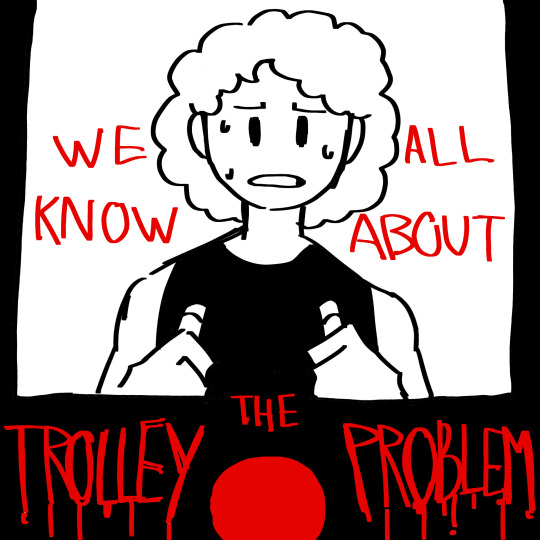
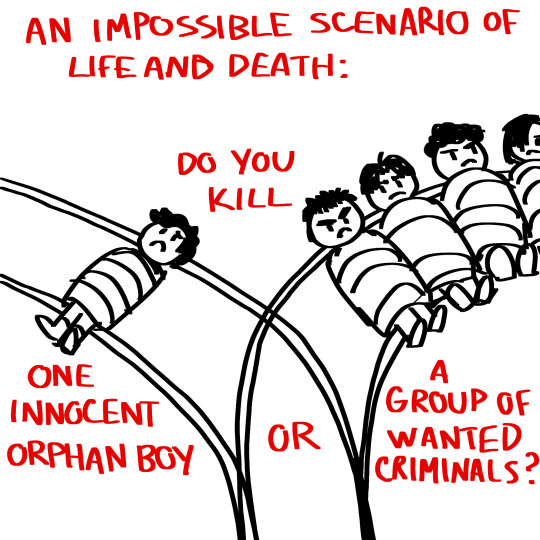
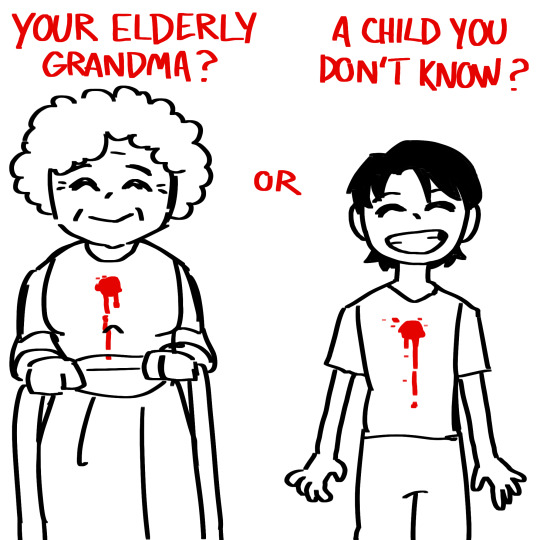
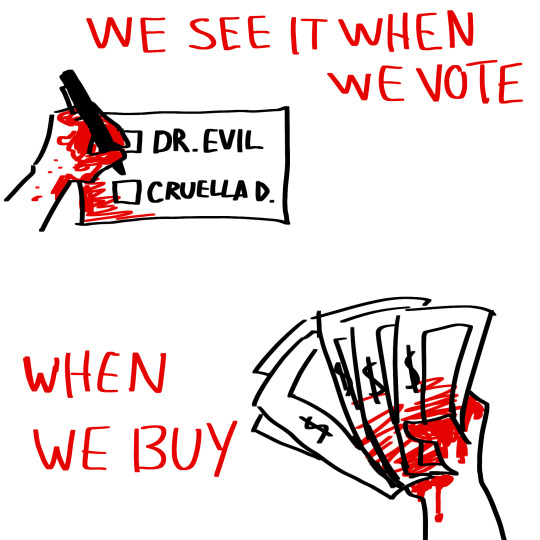
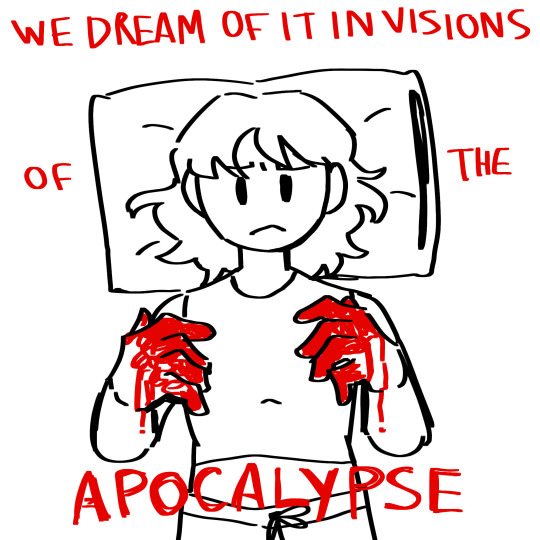
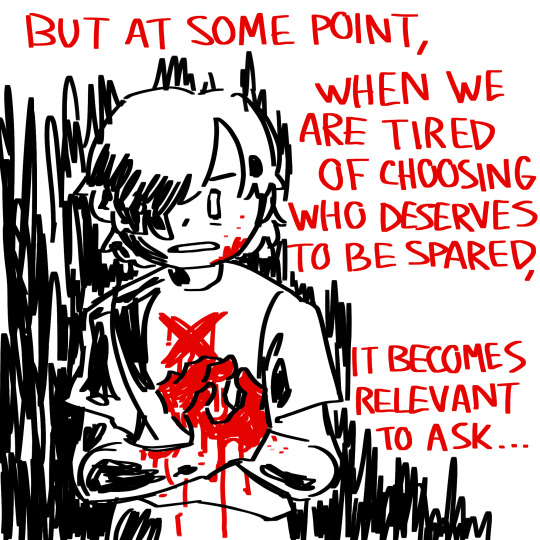
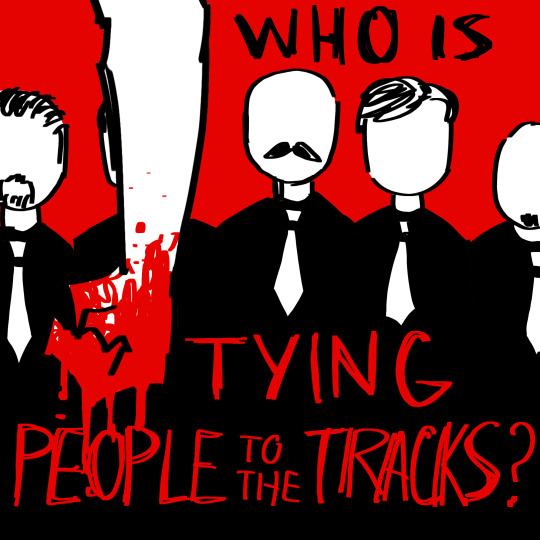
the trolley problem vs. systemic oppression: a comic.
88K notes
·
View notes























